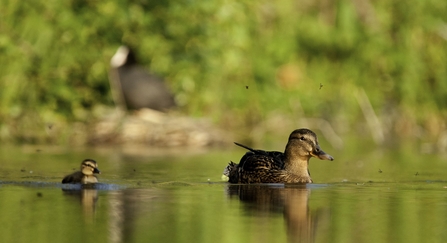Rutland Water is an internationally important site for many wildfowl species, but not just as a breeding site, as a winter feeding ground. Tens of thousands of wildfowl gather all around the reservoir to feed through the winter months. One of these species visits in particularly high numbers and is one of the reasons that gained Rutland Water its SSSI and RAMSAR status. That species is the wigeon!
Wigeon lawns at Rutland Water Nature Reserve
Chris Lawrence

Wigeon - Chris Gomersall/2020VISION
What is a wigeon?
The wigeon is a colourful duck that can often be spotted wheeling around our winter skies in large flocks, it is a winter visitor that gathers in large numbers, particularly on wet grasslands, floodplain meadows, flooded gravel pits, and reservoirs with gently sloping edges where they can easily get out onto the grassy banks. Wigeons are medium-sized ducks with a round head and short bill. Males are grey with a pink breast, orange head, yellow forehead, and obvious white wing patches that can be seen when they fly. Females are similar to Mallard females, but with rusty brown plumage and a pointed tail.
Wigeon is classed as a dabbling duck, but their preferred feeding habits are different from other breeds of dabbling duck that you may be familiar with, such as the mallard and gadwall. These species feed in shallow water on weed near the surface. Wigeon, however, although they do dabble and feed in shallow water, 80% of their diet is made up of surface-feeds of plants, seeds, and leaves.

Bertie Gregory/2020VISION
The wigeon start to arrive in September and October and their numbers gradually build up to reach over 4000 by January, so during this time, many of the grasslands fringing the shallow water lagoons of the nature reserve are managed in a way that enables the wigeon to feed. They don’t like to have to fly over woodland or scrub to get to their feeding areas, hence why all the grasslands on the edge of the water are managed for them, this way, if a predator approaches they can see it easily and hop very quickly back onto the water where they are safe.

The best tool to achieve the perfect sward (area of grass) is a sheep!
Sheep graze grass very close to the ground creating an expanse of short sward which is exactly what the wigeon like to feed on, so our hardy Hebrideans are vital for this important wintering duck before it heads back to its Northern Europe and Palearctic breeding grounds in March.

